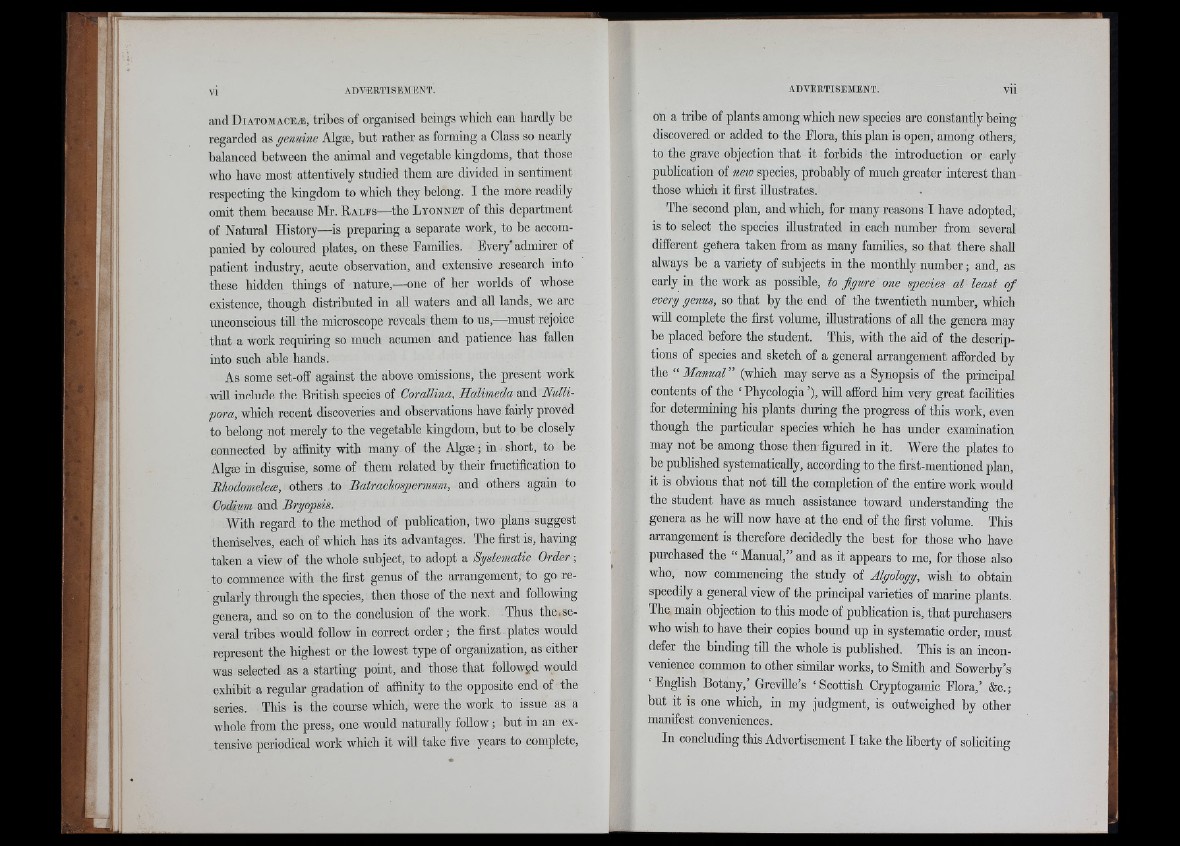
andDiAT0MACEA3, tribes of organised beings wliicli can hardly bo
regarded as gennine Algas, but rather as forming a Class so nearly
balanced between the animal and vegetable kingdoms, that those
who have most attentively studied them are divided in sentiment
respecting the kingdom to which they belong. I the more readily
omit them because Mr. R a l f s — the L y o n n e t of this department
of Natural History—is preparing a separate work, to be accompanied
by coloured plates, on these Families. Every’ admirer of
patient industry, acute observation, and extensive research into
these hidden things of nature,—one of her worlds of whose
existence, though distributed in all waters and all lands, we are
unconscious till the microscope reveals them to us,—must rejoice
that a work requiring so much acumen and patience has fallen
into such able hands.
As some set-off against the above omissions, the present work
will include the British species of Corallina, Halimeda and Nulli-
pora, which recent discoveries and observations have fairly proved
to belong not merely to the vegetable kingdom, but to be closely
connected by affinity with many of the Algae; in short, to be
Algae in disguise, some of them related by their fructification to
BhodomelecB, others to BatracJiospermum, and others again to
Codium and Bri/opsis.
With regard to the method of publication, two plans suggest
theniselves, each of which has its advantages. The first is, having
taken a view of the whole subject, to adopt a Systematic Order;
to commence with the first genus of the arrangement, to go regularly
through the species, then those of the next and following
genera, and so on to the conclusion of the work. Thus the.several
tribes would follow in correct order; the first plates would
represent the highest or the lowest type of organization, as either
was selected as a starting point, and those that followed would
exhibit a regular gradation of affinity to the opposite end of the
series. This is the course which, were the work to issue as a
whole from the press, one would naturally follow; but in an extensive
periodical work which it wiU take five years to complete,
on a tribe of plants among which new species are constantly being
discovered or added to the Elora, this plan is open, among others,
to the grave objection that it forbids the introduction or early
publication of new species, probably of much greater interest than
those wliioh it first illustrates.
The second plan, and which, for many reasons I have adopted,
is to select the species illustrated in each number from several
different gefiera taken from as many families, so that there shall
always be a variety of subjects in the monthly number ; and, as
early in the work as possible, to figure one species at least of
every genus, so that by the end of the twentieth number, which
will complete the first volume, illustrations of all the genera may
be placed before the student. This, with the aid of the descriptions
of species and sketch of a general arrangement afforded by
the “ Manual ” (which may serve as a Synopsis of the principal
contents of the ‘ Phycologia ’), will afford him very great facilities
for determining his plants during the progress of this work, even
though the particular species which he has under examination
may not be among those then figured in it. Were the plates to
be published systematically, according to the first-mentioned plan,
it is obvious that not tiU the completion of the entire work would
the student have as much assistance toward understanding the
genera as he will now have at the end of the first volume. This
arrangement is therefore decidedly the best for those who have
purchased the “ Manual,” and as it appears to me, for those also
who, now commencing the study of Algology, wish to obtain
speedily a general view of the principal varieties of marine plants.
The main objection to this mode of publication is, that purchasers
who wish to have their copies bound up in systematic order, must
defer the binding till the whole is published. This is an inconvenience
common to other similar works, to Smith and Sowerby’s
‘ English Botany,’ Greville’s ‘Scottish Cryptogamie Flora,’ &c.;
but it is one which, in my judgment, is outweighed by other
manifest conveniences.
In concluding this Advertisement I take the liberty of soliciting